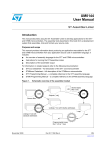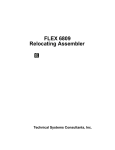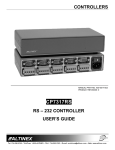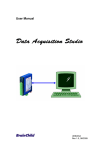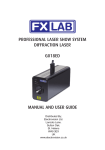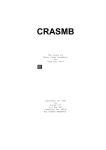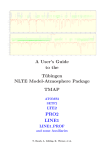Download Setra Systems 2000C Specifications
Transcript
DATUM ™ 00 20 Dual Channel Meter and Manometer Operating Manual 1 Contents INTRODUCTION ........................................................................................... 3 CONNECTING A TRANSDUCER TO THE DATUM 2000™ ........................ 4 TRANSMITTERS ( 2 WIRE DEVICES) ..................................................... 4 TRANSDUCERS ( 3 WIRE OR 3 TERMINAL DEVICES) ......................... 4 TRANSDUCERS ( 4 WIRE OR 4 TERMINAL DEVICES) ......................... 5 OPERATING NOTES .................................................................................... 7 OvEr AND UndEr MESSAGES ................................................................. 7 SAMPLING RATE ..................................................................................... 7 LOCKING ONTO A CHANNEL ................................................................. 7 DISPLAYING BOTH CHANNELS ............................................................. 7 MANOMETER ANALOG OUTPUT ........................................................... 7 RAPIDLY CHANGING INPUT SIGNAL .................................................... 7 TEST MODE ............................................................................................. 7 USER SETUPS ............................................................................................. 8 SET “OFFSET” .............................................................................................. 9 HI /LO ALARM SETPOINTS ....................................................................... 11 ALARM OUTPUT .................................................................................... 12 INSTALLATION OF PRESSURE FITTINGS FOR THE MANOMETER ..... 13 CALIBRATING THE DATUM 2000™. ......................................................... 14 CALIBRATING THE DATUM 2000™ USING KNOWN PRESSURES ... 14 CALIBRATING THE DATUM 2000™ USING AN EXTERNAL REFERENCE VOLTAGE: ....................................................................... 15 CALIBRATING THE DATUM 2000™ FOR A TRANSDUCER USING THE INTERNAL REFERENCE VOLTAGE ................................. 15 CALIBRATING THE DATUM 2000™ FOR A TRANSMITTER USING THE INTERNAL REFERENCE VOLTAGE ................................. 16 CALIBRATING VOLTAGE INPUT AND CURRENT INPUT ........................ 18 ERASING CALIBRATION IN A CHANNEL ................................................. 21 SETRA DATUM 2000™ RS232 SERIAL OPTION INTERFACE INSTRUCTIONS ..................................................................................... 23 DATUM 2000™ SERIAL OPTION COMMANDS .................................... 23 OUTPUT DATA FORMAT ....................................................................... 24 CHANGING THE BAUD RATE AND PARITY ........................................ 25 DATUM 2000™ MANOMETER SPECIFICATIONS .................................... 26 DATUM 2000™ METER AND MANOMETER SPECIFICATIONS ............. 27 PANEL MOUNT INSTRUCTIONS .............................................................. 28 "FCC WARNING" ........................................................................................ 30 RETURN INSTRUCTIONS ......................................................................... 31 LIMITED WARRANTY AND LIMITATION OF LIABILITY ........................... 31 2 DATUM 2000™ INTRODUCTION Thank you for purchasing a Setra DATUM 2000™ meter or manometer. Setra’s DATUM 2000™ is a compact dual channel meter with a 4 1/2 digit LED display designed to mate with one or two transducers or transmitters with a cable connection. The DATUM 2000™ manometer is a single unit which combines a DATUM 2000™ meter with a Setra transducer. The Setra transducer is connected to the Channel One inputs of the manometer, with Channel Two inputs available for external connection to another Setra transducer or transmitter. The DATUM 2000™ meter and manometer are easy to use and install and may be used on a benchtop or panel-mounted. IMPORTANT Please familiarize yourself with each set of instructions before attempting to install your meter or manometer or perform a procedure. The meter has a "time-out" safety feature to prevent miscalibration. Every time a new message is displayed during a procedure, you have 30 seconds to respond. If you don't respond within 30 seconds the meter will reset itself to normal operation. 3 CONNECTING A TRANSDUCER TO THE DATUM 2000™ Note: If you purchased your DATUM 2000™ factory calibrated with a Setra pressure transducer or transmitter, a 10 foot cable/connector assembly has been provided. Therefore, this section may not be applicable. Go to page 7. The DATUM 2000™ has two groups of input terminals, one for each channel. Figure B (page 6) shows the terminal block connector on the back of the DATUM 2000™ and describes each position of the connector. Figure A shows a typical setup of a DATUM 2000™ with a single transducer. The DATUM 2000™ provides ground referenced 12 volt and 24 volt excitation. The 24 volt excitation is available on pins 5 and 11. The 12 volt excitation is available only on pin 10. (If two 12 volt transducers [transmitters] are being used, both units must be connected to pin 10.) DO NOT USE THE EXCITATION FROM THE METER TO POWER ANY OTHER DEVICE BESIDES THE 1 OR 2 TRANSDUCERS OR TRANSMITTERS THAT THE METER IS DISPLAYING. UNDER NO CIRCUMSTANCES SHOULD MORE THAN 60 mA BE DRAWN FROM THE DATUM. Setra transducers come in two configurations: 3 wire (3 terminal) circuits and four terminal equivalent circuits. The Setra transmitters are known as 2 wire circuits. The instructions for connecting each of these to the DATUM 2000™ follows: TRANSMITTERS ( 2 WIRE DEVICES) Connect the + excitation to pin 5 (CH2: pin 11) to supply 24 volts to the transmitter. Connect the - excitation to pin 8 (CH2: pin 14) to return the signal to the DATUM 2000™. TRANSDUCERS ( 3 WIRE OR 3 TERMINAL DEVICES) Connect the + excitation to pin 5 (CH2: pin 11) to supply 24 volts to the transducer. IF YOUR TRANSDUCER REQUIRES 12 VOLT EXCITATION, CONNECT THE + EXCITATION TO PIN 10 (CH2: PIN 10). Connect the - excitation to Ground, pin 9 (CH2: pin 15). Connect the + output to +IN, pin 6* (CH2: pin 12). Connect the -IN terminal, pin 7* (CH2: pin 13) to Ground, pin 9 (CH2: pin 15). Connect the shield to Ground, pin 9 (CH2: pin 15). 4 TRANSDUCERS ( 4 WIRE OR 4 TERMINAL DEVICES) Connect the + excitation to pin 5 (CH2: pin 11) to supply 24 volts to the transducer. IF YOUR TRANSDUCER REQUIRES 12 VOLT EXCITATION, CONNECT THE + EXCITATION TO PIN 10 (CH2: PIN 10). Connect the - excitation to Ground, pin 9 (CH2: pin 15). Connect the + output to +IN, pin 6* (CH2: pin 12). Connect the - output to -IN, pin 7* (CH2: pin 13). Connect the shield to Ground, pin 9 (CH2: pin 15) *NOTE: THE OUTPUT OF THE SETRA TRANSDUCER INSTALLED IN THE DATUM 2000™ MANOMETER IS AVAILABLE ON PIN 6 AND 7. DO NOT APPLY AN ELECTRICAL SIGNAL TO CH1: PIN 6 or CH1: PIN 7. A SECOND TRANSDUCER MAY BE CONNECTED ONLY TO CH2: PIN 12 or CH2: PIN 13. Setra pressure/vacuum Transmitter AC Adapter Channel 1 Inputs/Excitations Channel 2 Alarm Signals DANGER REFERENCE VOLTAGE > > > > > > SEE CALIBRATION INSTRUCTIONS BEFORE USING REF. VOLTAGE Inputs/Excitations Supplied with connector to join the two foot transducer cable and the ten foot digital pressure readout cable Pressure Line (installed by user) 238652 REV B Figure A 5 Figure B Terminal Block Connector 1 2 3 4 5 6 7 8 9 10 111213 14 15 Alarm Signals Channel 1 Inputs/Excitations Channel 2 Inputs/Excitations Setra Transducer* Pin Description 1 . Ground 2 . HiALArm 3 . Lo ALArm 4 . Ch.1/Ch.2 5 . +24Voltsexcitation White Red 6 . Ch.1+In Yellow Green 7 . Ch.1-In Brown White 8 . Ch.1Currentinput 9 . Ground 10. +12Voltsexcitation(optional) Caution:Donot common toPin5orPin11(+24Vexc.) White Red 11. +24Voltsexcitation Caution:Donot common toPin10(+12Vexc.) White Red 12.. Ch.2 +In Yellow Green 13. Ch.2 -In Brown White 14. Ch.2Currentinput 15. Ground Setra Transmitter* w/RedCable w/GrayCable w/GrayCable Red Black Black/Shield Black/Shield Shield Red Black Black/Shield Black/Shield Shield *IMPORTANT: If you are not using a Setra transducer or transmitter, see manufacturer's transducer/transmitter operating instructions for terminal circuit configuration and then connect the wires to the corresponding pins listed in the above chart. 6 OPERATING NOTES OvEr AND UndEr MESSAGES In addition to displaying the numeric pressure reading, the DATUM 2000™ may also display "UndEr" and OvEr". If the pressure reading exceeds +31999 (disregard decimal point), the display will not show the input pressure, instead it will display "OvEr". If the pressure reading is less than -9999 (disregard decimal point), the display will not show the input pressure, instead it will display "UndEr". SAMPLING RATE The DATUM 2000™ will read the channel, 2 to 3 times a second. The speed of the update is determined by the voltage of the channel being read. If the meter has two channels calibrated, it will display each channel for 8 readings, and then switch to the other channel. The exact time the meter will display a channel is dependent on the voltage of that channel. Each channel will be displayed for approximately 3 to 4 seconds. LOCKING ONTO A CHANNEL Press the HOLD/mode key to force the DATUM 2000™ to continuously display the present channel. Upon power-up, the Datum 2000™ will display both channels. DISPLAYING BOTH CHANNELS Press the SCAN/adj key to force the DATUM 2000™ to resume displaying both channels. MANOMETER ANALOG OUTPUT The output of the Setra transducer installed in the DATUM 2000™ Manometer is available at the rear terminal strip on pins 6 and 7 and marked Channel 1 +IN, Channel 1 -IN RAPIDLY CHANGING INPUT SIGNAL For a signal whose magnitude is increasing very rapidly, the DATUM 2000™ can select the wrong integration time. This can cause a single reading overflow of the A/D converter. This overflow can cause the sign of the reading to be incorrectly set. Such an occurrence can cause an improper setting of the alarms. This condition will self-correct once the input signal has stabilized. This occurrence will rarely, if ever, be seen. TEST MODE There is a test mode in which the DATUM 2000™ will display the output of the A/D converter reading of Channel 1 without performing the units conversion. This mode is accessible only by holding both the SCAN/adj and HOLD/mode keys down when the power is applied to the DATUM 2000™. If you accidentally enter this mode, you can exit by pressing either key. 7 USER SETUPS The menu tree below represents the meter program structure. To enter the menu and select a channel, press and hold the SCAN/adj and HOLD/mode keys for 8 seconds, then release; the display will alternate between “cal” and “noYes” for ten seconds.* To specify “yes” and select “CH1”, press and hold the HOLD/mode key until “CH1” displays. To specify “no”, press and hold the SCAN/adj key. The display will return to normal operation. (To select “CH2”: With “CH1” displayed, press and release the SCAN/adj key to display “CH2”.) When choosing menu options, you have 30 seconds to press a key before the meter defaults to normal operating mode. To view the commands listed for the displayed channel, press and release the HOLD/mode key to display “ALAr” . Then press and release the SCAN/ adj key (repeat) to display each command until the display returns to normal operation. *NOTE: If the meter has not been calibrated at the factory, when the meter is turned on, the display will alternate between “cal” and “noYes” . ALAr Set the alarm points. OFF57 Set an offset value. CH1 CAL_U Calibrate CH1 for voltage in (transducer). CAL_C Calibrate CH1 for current in (transmitter). SCAN adj Return to normal operation. Display cal 0.000 Cal is lit when in calibration mode. HOLD mode ALAr Set the alarm points. OFF57 Set an offset value. CAL_U Calibrate CH2 for voltage in (transducer). CH2 CAL_C Calibrate CH2 for current in (transmitter). Return to normal operation. Return to normal operation. 8 SET “OFFSET” (please read before attempting procedure) Note: The channel must be calibrated before the offset is adjusted. The ”OFFSET” command allows you to adjust the reading relative to a known value. To set the ”OFFSET” use the following procedure: Step 1. Press and hold the SCAN/adj and HOLD/mode keys for 8 seconds, then release; the display will alternate between “cal” and “noYes” for ten seconds. 0.00 SCAN adj HOLD mode CAL Step 2. To specify “yes” and select “CH1”, press and hold the HOLD/mode key to display “CH1” . (To select “CH2”: With “CH1” displayed, press and release the SCAN/adj key to display “CH2”.) noYES SCAN adj HOLD mode CH1 Step 3. Press the HOLD/mode key to display “ALAr”. CH1 SCAN adj HOLD mode ALAr Step 4. Press the SCAN/adj key to display “OFFST”. ALAr SCAN adj HOLD mode OFF57 9 Step 5. Press the HOLD/mode key to display the number “0”. Note: The decimal point that was set during calibration (CAL_U, CAL_C) will be displayed. OFF57 SCAN adj HOLD mode 0. Step 6. Set the value you wish the meter to display at the presently applied pressure. Press the SCAN/adj key to move the numbers up (+). 0. SCAN adj HOLD mode 25. Press the HOLD/mode key to move the numbers down (-). 0. SCAN adj HOLD mode –25. When the desired number is reached, press the SCAN/adj and HOLD/mode keys at the same time. The number will flash repeatedly. Then, press the SCAN/adj key to readjust the number or the HOLD/mode key to accept it. After the number is accepted, the meter will display “bUSY” for 10 seconds and then resume normal operation. 10 HI /LO ALARM SETPOINTS (please read before attempting procedure) Note: The channel must be calibrated before the alarm points are set. The “ALAr” command allows you to set high and low pressure alarm points. The HI ALARM or LO ALARM indicator light is lit if the applied pressure exceeds the set values. The alarm output signals are available at the terminal strip. To set the Hi ALARM and Lo ALARM, use the following procedure: Step 1. Press and hold the SCAN/adj and HOLD/mode keys for 8 seconds, then release; the display will alternate between “cal” and “noYes” for ten seconds. 0.00 SCAN adj HOLD mode CAL Step 2. To specify “yes” and select “CH1”, press and hold the HOLD/mode key to display “CH1”. (To select “CH2”: With “CH1” displayed, press and release the SCAN/adj key to display “CH2”.) noYES SCAN adj HOLD mode CH1 Step 3. Press the HOLD/mode key to display “ALAr”. CH1 SCAN adj HOLD mode ALAr Step 4. Press the HOLD/mode key to display the present value of the Low Alarm point. ALAr SCAN adj HOLD mode 0. 11 Step 5. Set the LO ALARM Point. Note: The decimal point that was set during calibration (CAL_U, CAL_C) will be displayed. Press the SCAN/adj key to move the numbers up (+). 0. SCAN adj HOLD mode 25. Press the HOLD/mode key to move the numbers down (-). 0. SCAN adj HOLD mode –25. When the desired number is reached, press the SCAN/adj and HOLD/mode keys at the same time. The number will flash repeatedly. Then, press the SCAN/adj key to readjust it or the HOLD/mode key to accept it. Step 6. Repeat the same procedure as in Step 5 to set the HI ALARM Point. After the number is accepted the DATUM 2000™ will resume normal operation. ALARM OUTPUT The alarm outputs are available on the terminal strip on the back of the meter. The signals available are HI ALARM, position 2, LOW ALARM, position 3, and CH1/CH2, position 4. A TTL level ( 5 volt logic ) high signal on the LOW or HIGH alarm lines indicates an alarm condition. The corresponding LED on the front panel will also be lit. If pin 4, “CH1/CH2” is low, the alarmed channel is Channel 2; if pin 4 is high, the alarmed channel is Channel 1. These lines can sink up to 12 mA or source up to 8 mA. Keep in mind that the meter will continue to scan both channels if 2 channels are calibrated and the DATUM has not been locked onto a single channel. The alarm outputs will change to represent the channel being displayed. 12 INSTALLATION OF PRESSURE FITTINGS FOR THE MANOMETER Your transducer is designed for most accurate operation when subjected to pressures within the designated pressure range. Refer to catalog bulletin specifications for proof pressure limits. Subjection to excessive pressure voids the warranty. DO NOT OVERPRESSURE. CAUTION: DO NOT SUBMERGE IN LIQUIDS, USE IN AMBIENT CONDITIONS CORROSIVE TO ANODIZED ALUMINUM, SUBJECT TO SPRAY OR DRIPPING, OR USE IN A HIGH VIBRATION ENVIRONMENT. THE TRANSDUCER IS VERY SLIGHTLY SENSITIVE TO ACCELERATION IN THE PRESSURE FITTING AXIS (SEE APPLICABLE SPECIFICATIONS BULLETIN FOR ACCELERATION RESPONSE SPECIFICATIONS). Standard thread sealants such as Teflon pipe tape generally are satisfactory. For the most sensitive pressure ranges, excessive high torquing of a metal pressure fitting may cause slight zero shift which may be trimmed out using the “OFFSET” adjustment. Use of a plastic fitting often shows no noticeable zero shift. The torquing effect does not appreciably affect linearity or sensitivity. The wrench flat on the pressure port should be used when installing the positive pressure fitting. See page 26 for transducer specifications and media compatibility. 13 CALIBRATING THE DATUM 2000™. Note: If on power up, the Datum 2000™ display alternates between "cal" and "no Yes", it has not been calibrated at the factory. If the Datum 2000™ (Channel 1 or 2) displays numbers on power up, one or both channels have been calibrated at the factory. Always allow the DATUM 2000™ and the transducers, transmitters, or reference voltage supplies to warm-up 10 minutes before performing a calibration. Whenever possible, it is best to calibrate the DATUM 2000™ at the temperature expected during operation. There are 3 ways to calibrate the DATUM 2000™: Applying pressure to a transducer or transmitter connected to the DATUM 2000™; applying voltage to simulate the transducer, or current for a transmitter, directly to the DATUM 2000™; or using the DATUM 2000™’s internal reference voltage. The way you should calibrate your meter depends on the equipment you have available. If you can apply very accurate and stable pressures, use this method. If you have a precision voltage source, use it to simulate the transducer’s output. If you have a precision current source, use it to simulate the transmitter’s output. If you cannot calibrate your DATUM 2000™ with the methods above, you can use the internal reference voltage to calibrate your DATUM 2000™. CAUTION (DATUM 2000™ MANOMETER ONLY): CALIBRATING CHANNEL ONE OF THE DATUM 2000™ MANOMETER WITH A VOLTAGE INPUT WILL RESULT IN DAMAGE TO THE DATUM AND WILL VOID THE WARRANTY. THE DATUM 2000™ MANOMETER HAS BEEN CALIBRATED AT THE FACTORY FOR THE SETRA TRANSDUCER INSTALLED INSIDE. IF YOU WISH TO PERFORM A CALIBRATION ON THE DATUM 2000™ MANOMETER, YOU MUST APPLY KNOWN PRESSURE TO THE TRANSDUCER. NEVER APPLY A VOLTAGE SIGNAL TO THE CHANNEL ONE INPUTS (PINS 6 AND 7) ON THE BACK OF THE DATUM 2000™ MANOMETER. NOTE: THE OUTPUT OF THE SETRA TRANSDUCER INSTALLED IN THE DATUM 2000™ MANOMETER IS AVAILABLE AT THE REAR TERMINAL STRIP ON PINS 6 AND 7 AND MARKED CHANNEL 1 +IN, CHANNEL 1 -IN. CALIBRATING THE DATUM 2000™ USING KNOWN PRESSURES To calibrate the DATUM 2000™ with known pressures, be sure the DATUM 2000™ and the transducer or transmitter is properly connected as described on pages 4 - 6. Following the calibration procedures starting on page 18, enter the known pressure of the system for the calibration points. 14 CALIBRATING THE DATUM 2000™ USING AN EXTERNAL REFERENCE VOLTAGE: Connect the external reference to the meter to simulate the transducer or transmitter using the connection instructions on pages 4 - 6. Then, follow the calibration instructions on page 18. During calibration, short -IN to Ground, pin 7 and pin 9 (CH2: pin 13 and pin 15). Be sure to set the minimum voltage of the calibrator to the same value as the minimum output voltage of the transducer. Apply the voltage/current for the first pressure point and enter the pressure reading desired. Now apply the voltage/current for the second pressure point and enter the desired pressure reading. CALIBRATING THE DATUM 2000™ FOR A TRANSDUCER USING THE INTERNAL REFERENCE VOLTAGE The DATUM 2000™ has a very stable internal reference voltage which can be used for calibration if the above methods cannot be used. For the first pressure point the +IN, -IN and ground should all be shorted together, pin 6, pin 7, and pin 9 (CH2: pin 12, pin 13, and pin 15). Enter the pressure that corresponds to zero volts input. Use the following formula to calculate the pressure that corresponds to zero volts input (see examples). SLOPE = Full scale pressure – offset pressure ————————————————— Full scale voltage – offset voltage OFFSET = Pressure ( @ voltage ) – (SLOPE x voltage) PRESSURE = (SLOPE x VOLTAGE) + OFFSET (DEFINITION OF OFFSET: Offset pressure and offset voltage refers to the minimum pressure input and voltage output of the transducer, e.g., a 0-5 volt output, 600-1100 mbar transducer, the offset voltage is 0 and the offset pressure is 600.) For the second pressure point, the -IN and ground should be shorted, pin 7 and pin 9 (CH2: pin 13 and pin 15). The reference voltage (either contact of the 2 pin blue connector located behind the terminal strip) should be connected to the +IN, pin 6 (CH2: pin 12). Enter the pressure that corresponds to this input voltage according to the formula above; the value of the reference voltage is recorded on the serial number label on the bottom of the DATUM 2000™. 1st example: A 1000 PSI transducer has no offset voltage and an output of 5 volts at 1000 psi. The DATUM 2000™ has a reference voltage of 2.4995. SLOPE = 1000 – 0 ————— = 200 5–0 OFFSET = 0 – 200 x 0 = 0 15 PRESSURE (@ 0) = 200 x 0 + 0 = 0 PRESSURE (@ REF) = 200 x 2.4995 + 0 = 499.9 2nd example: A 20 psi transducer has an offset of .1 volts and will have an output of 5.1 volts for a 20 PSI pressure. The DATUM 2000™ has a 2.4993 reference voltage. SLOPE = 20 – 0 ———— = 4 5.1 – .1 OFFSET = 0 – 4 x .1 = –.4 PRESSURE (@0) = 4 x 0 – .4 = –.4 PRESSURE (@ REF) = 4 x 2.4993 – .4 = 9.597 3rd example: A bidirectional transducer has +/- 2.5 volt output for +/- 14.70 reading. The DATUM 2000™ has a reference voltage of 2.5082 volts. SLOPE = 14.70 – (–14.70) —————————— = 5.88 2.5 – (–2.5) OFFSET = 14.70 – 5.88 x 2.5 = 0 PRESSURE (@ 0) = 0 x 5.88 – 0 = 0 PRESSURE (@ REF) = 2.5082 x 5.88 – 0 = 14.75 CALIBRATING THE DATUM 2000™ FOR A TRANSMITTER USING THE INTERNAL REFERENCE VOLTAGE The DATUM 2000™ has a very stable internal reference voltage which can be used for calibration with transmitters. Before proceeding you must locate the label on the bottom of the DATUM 2000™ which indicates the reference voltage and the value of the transmitter input impedance for the channel you wish to calibrate. 16 For the first pressure point connect the "mA" to gound, pin 8 to pin 9 (CH2: pin 14 to pin 15). Enter the pressure that corresponds to zero mA input (since most transmitters are 4 to 20 mA, 0 mA will have a negative value). Use the following formula (see example): SLOPE = Full scale pressure – offset pressure ———————————————————— Full scale mA – offset mA OFFSET = Pressure ( @ mA ) – (SLOPE x mA) mA = REFERENCE VOLTAGE / INPUT IMPEDANCE PRESSURE = (SLOPE x mA) + OFFSET (DEFINITION OF OFFSET: Offset pressure and offset current (mA) refers to the minimum pressure input and current output of the transmitter, e.g., a 4-20 mA output, 0 - 50 psi transmitter, the offset current is 4 mA and the offset pressure is 0.) For the second pressure point, connect the reference voltage (either contact of the 2 pin blue connector located behind the terminal strip) to the "mA", pin 8 (CH2: pin 14). Enter the pressure that corresponds to this input current according to the formula above; the value of the reference voltage and the "mA" input impedance is recorded on the serial label on the bottom of the DATUM 2000™. Example: A 1000 PSI transmitter outputs 4 mA at 0 PSI and 20 mA at 1000 psi. The DATUM 2000™ has a reference voltage of 2.4995 and channel 1 input impedance is 149.01 ohms. SLOPE = 1000 – 0 ————— = 62.5 20 – 4 OFFSET = 0 – 62.5 x 4 = -250 PRESSURE (@0) = mA = 62.5 x 0 – 250 = –250 2.4995/149.01 = 16.774 mA (0.016774 Amps) PRESSURE (@ REF) = 62.5 x 16.774 – 250 = 798.4 17 CALIBRATING VOLTAGE INPUT AND CURRENT INPUT (please read before attempting procedure) CAL_U and CAL_C commands allow you to calibrate the DATUM 2000™ by entering two data points. (Calculate the pressure for the 2 calibration points before beginning this procedure.) The DATUM 2000™ will determine the conversion factor and display the applied pressure in the desired engineering units. The maximum read-out is +31999 to -9999. If unit has been previously calibrated the calibration must be erased before calibrating the meter. Following this procedure without erasing the previous calibration will not reprogram the meter. Note: If at anytime you with to abort the calibration procedure, simply disconnect power to the unit and the old calibration data will still be intact. CAUTION: CALIBRATING CHANNEL ONE OF THE DATUM 2000™ MANOMETER WITH A VOLTAGE INPUT WILL RESULT IN DAMAGE TO THE DATUM AND WILL VOID THE WARRANTY. THE DATUM 2000™ MANOMETER HAS BEEN CALIBRATED AT THE FACTORY FOR THE SETRA TRANSDUCER INSTALLED INSIDE. IF YOU WISH TO PERFORM A CALIBRATION ON THE DATUM 2000™ MANOMETER, YOU MUST APPLY KNOWN PRESSURE TO THE TRANSDUCER. NEVER APPLY A VOLTAGE SIGNAL TO THE CHANNEL ONE INPUTS (PINS 6 AND 7) ON THE BACK OF THE DATUM 2000™ MANOMETER. *Before beginning set up wiring for first calibration point. If using the internal reference voltage, +IN, -IN and ground should all be shorted together, pin 6, pin 7 and pin 9 (CH2: pin 12, pin 13 and pin 15). Step 1. Press and hold the SCAN/adj and HOLD/mode keys for 8 seconds, then release; the display will alternate between “cal” and “noYes” for ten seconds. 0.00 SCAN adj HOLD mode CAL Step 2. To specify “yes” and select “CH1”, press and hold the HOLD/mode key to display “CH1” . (To select “CH2”: With “CH1” displayed, press and release the SCAN/adj key to display “CH2”.) noYES SCAN adj HOLD mode CH1 Step 3. Press the HOLD/mode key to display “ALAr”. CH1 SCAN adj HOLD mode ALAr 18 Step 4. Press the SCAN/adj key to display “OFFST”. ALAr SCAN adj HOLD mode OFF57 Step 5. To calibrate voltage in (transducer), press the SCAN/adj key to display “CAL U”. (If calibrating for voltage input, proceed to Step 7, if not, proceed to Step 6 to calibrate for current input.) OFF57 SCAN adj HOLD mode CAL_U Step 6. To calibrate current in (transmitter), press the SCAN/adj key again to display “CAL_C”, then proceed to Step 7. CAL_U SCAN adj HOLD mode CAL_C Step 7. Setting the Decimal Point. Note: The decimal point location set in this step will always be used for all displayed pressure readings on this channel. The maximum read-out is +31999 to -9999. Press the HOLD/mode key to display “SETdP”. CAL_U SCAN adj HOLD mode SE7dP. Step 7a. Press and hold the SCAN/adj key and the decimal point will move to the left, release key at desired location. (While the key is pressed, the decimal will continue moving, left to right.) Press and release the SCAN/adj key to move the decimal point one place at a time. SE7dP. SCAN adj HOLD mode SE.7dP 19 Step 7b. Press the HOLD/mode key to accept the decimal point and the meter will display the decimal point with zeroes. S.E7dP SCAN adj HOLD mode 0.000 Step 8. Enter a calibration data point. (Enter a number between +31999 and -9999.) Note: The pressure or voltage/current must be applied to the appropriate channel before entering this data point. Caution: Do not try to calibrate Channel One of the DATUM 2000™ Manometer with a voltage input, this will damage the unit and void the warranty. Never apply a voltage signal to the Channel One inputs (see page 14). Press the SCAN/adj key to move the numbers up (+). 0.000 SCAN adj HOLD mode 30.000 Press the HOLD/mode key to move the numbers down (-). 0.000 SCAN adj HOLD mode —0.100 When the desired number is reached, press the SCAN/adj and HOLD/mode keys at the same time. The number will flash repeatedly. Then, press the SCAN/adj key to readjust the number or the HOLD/mode key to accept it. After the calibration data point has been accepted, the meter will display “bUSY” for 10 seconds and then display zero. The second data point may be entered. **Set up wiring for second calibration point. The meter is programmed to allow unlimited time for this wiring. It will not default to normal operating mode. If using the internal reference voltage, the -IN and ground should be shorted, pin 7 and pin 9 (CH2: pin 13 and 15). The reference voltage (either contact of the 2 pin blue connector located behind the terminal strip) should be connected to the +IN, pin 6 (CH2: pin 12). 20 Step 9. Repeat the same procedure as in Step 8 to enter the second calibration data point. (Enter a number between +31999 and -9999.) After the second calibration data point has been accepted, the meter will display “bUSY” for 10 seconds and then return to normal operating mode and immediately begin reporting. ERASING CALIBRATION IN A CHANNEL (please read before attempting procedure) A channel of the Datum 2000 can be permanently deactivated by calibrating the channel and entering zero for both pressure points. If you wish to erase the calibration of a channel, follow the procedure beginning with Step 1, on page 18. In Step 5, Select "CAL U". In Step 7, 7a and 7b, set the decimal point to the first position. In Steps 8 and 9, enter a value of 0. (It does not matter what, if any, voltage or current signals are applied to the Datum 2000 when you use the Calibration Procedure to erase a channel, as long as they do not exceed the Datum's input specifications.) 21 22 SETRA DATUM 2000™ RS232 SERIAL OPTION INTERFACE INSTRUCTIONS The serial option for the Setra DATUM 2000™ has a 9 pin d-sub connector for connecting the serial interface. The following pinout is used by the Serial Option: 12345 00000 0000 6789 Pin 2 3 5 Description Transmit (from DATUM) Receive (into DATUM) Signal Ground The DATUM 2000™ Serial option operates with the following default parameters: Baud 2400 Parity None Start bits 1 Data bits 8 Stop bits 1 The DATUM 2000™ does not support hardware or software handshaking, e.g. RTS, CTS, DTR, and DSR are not supported, nor is XON/XOFF handshaking supported. Some computer equipment expects handshaking; for instance, it may be necessary to jumper RTS to CTS at your computer's serial input port, it may also be necessary to jumper DTR to DSR. Shielded cables must be used with this unit to ensure compliance with the Class A, Part 15 FCC limits. DATUM 2000™ SERIAL OPTION COMMANDS A 41H Transmit every reading that is displayed by the meter with an alarm condition indicated. Note: If the DATUM 2000™ is locked onto a channel, the other channel will not print even if it is in an alarm condition. See page 11 for setting the alarm points. C 43H Transmit the readings displayed on the DATUM 2000™ continuously. Note this will transmit the active channel(s); if the DATUM 2000™ is locked onto a channel, only that channel will be transmitted. Hint: use command 1 or 2 to lock onto a channel and then use C to print it continuously. 1 31H Set the DATUM 2000™ to channel one and lock the meter so only channel one is displayed. It then transmits one reading for channel one. Channel one must be calibrated. 23 2 32H Set the DATUM 2000™ to channel two and lock the meter so only channel two is displayed. It then transmits one reading for channel two. Channel two must be calibrated. S 53H Force the DATUM 2000™ to scan all active channels. This has no effect for a DATUM 2000™ with only one channel calibrated. V 56H Verify communication with the DATUM 2000™ Serial Option. The DATUM 2000™ will respond "SETRA DATUM 2000". When command A or C is active, the alarm print or continuous print will continue until interrupted by a new command. The command that interrupts the printing will not be read; therefore, to start a new command while the Serial Option is outputting continuous data, send the new command twice. Allow 1 second between commands transmitted to the DATUM 2000™. Hint: Transmit a V to the DATUM 2000™, if the verify message, "SETRA DATUM 2000", is not received, wait 1 second, and retransmit a V. Transmit a V each second until the verification message is received. When the verification message is received, the DATUM 2000™ is ready for a new command. OUTPUT DATA FORMAT The data is transmitted by the DATUM 2000™ Serial option in the following format, followed by a carriage return and a line feed. C:nnnnn,SS C the channel number: "1" or "2". nnnnn the number or message displayed on the DATUM 2000™. SS Status: "OK", "HI" for high alarm and "LO" for low alarm. Examples of data: 1: 9.298, 2: 11.438, 2: 0.UEr, 1: Un.dEr, 1: -11.04, OK HI HI OK LO The decimal point is always transmitted in the position programmed for display by the DATUM 2000™. For messages such as OVER and UNDER, the decimal point will appear in the message as above. If the DATUM 2000 is in calibration mode, the DATUM will output "CAL" once and then wait for a new command. 24 CHANGING THE BAUD RATE AND PARITY The baud rate and parity of the DATUM 2000™ Serial Option can be set to the following values: BAUD: 300 600 1200 2400 4800 9600 PARITY: NONE ODD EVEN COMMAND 3 6 1 2 4 9 ASCII 33H 36H 31H 32H 34H 39H N O E 4EH 4FH 45H To change the baud or parity, transmit a P, ASCII 50H, and the command number or letter from the table above. For example, to set the DATUM 2000™ to 9600 baud and even parity, transmit P (always allow 1 second between commands sent to DATUM 2000™) and then transmit 9, to set the baud rate to 9600. Set your computer or terminal to 9600 baud and then transmit P and E to set even parity. When you change the communications parameters, they are stored internally and will be recalled every time the DATUM 2000™ is powered up. Hint: Transmit a V to the DATUM 2000, if the verify message "SETRA DATUM 2000", is not received, wait 1 second, and retransmit a V. Transmit a V each second until the verification message is received. When the verification message is received, the DATUM 2000™ is ready for a new command. Now transmit a P, wait at least 1 second and transmit the baud or parity parameter. 25 DATUM 2000™ Manometer Specifications Type of Pressure Measurement w/Models 204/204D w/Model 239 w/Model 270 Gage Absolute Vacuum Differential Differential Gage Gage Absolute Barometric 0 to 25, 50, 100, 250, 500,1000 psig 0 to 25, 50, 100, 250, 500, 1000 psia 0 to 25, 50, 100 psid 0 to 14.7 psiv 0 to ±10, ±25, ±50, ±100 psid 0to0.5,1.0,2.5,5, 15, 30 inch WC 0 to ±0.25, ±.5, ±1.0, ±2.5, ±7.5, ±15 inch WC 0 to 5, 10 psid 0 to ±2.5, ±5 psid 0 to 5, 10, 20, 50, 100 psig 0 to 10, 20, 50, 100 psia 600-1100millibar 800-1100millibar Standard Ranges System Accuracy (RSS) ±0.11% FS ± 2 digits ±0.14% FS ± 2 digits ±0.05% FS ± 2 digits 0.14 max. ± 4 digits 0.11 max. ± 4 digits 0.35 max. ± 4 digits 0.35 max. ± 4 digits 0.07 max. ± 4 digits 0.04 max. ± 4 digits Positive 1/4"-18 NPT internal 1/8"-27NPT internal 1/8"-27NPT internal Reference 1/8"-27 NPT internal (204D only) 1/8"-27NPT internal N/A Positive Gas or liquid compatible with 17-4 PH stainlesssteel. Gases compatible withstainlesssteel, hard anodized 6061 aluminum, Buna N O-ring. (Stainlesssteelin place of aluminum onspecialorder.) Dry or wet air, water or other media compatible with aluminum, alumina ceramics, gold and elastomer sealant. Reference Clean dry air or other gases. (Non-corrosive, non-condensable.) Maximum line pressure 1000 psig (204D only) Clean dry air or other N/A gases. (Non-corrosive, non-condensable.) Maximum line pressure 250 psig Normally 0 to 5 VDC for unidirectionalpressure or vacuum ranges. 0 to ±2.5 VDC for bidirectionalranges. Normally 0 to 5 VDC forunidirectional pressure. 0 to ±2.5 VDC for bidirectionalranges. Thermal Effects %FS 60O-95OF Thermal Zero Shift Thermal Span Shift Pressure Fittings Pressure Media Analog Output Notes: 0 to 5 VDC for gage and absolute ranges. (1) Differential pressure models can be used to measure gage pressure by leaving the reference port open to atmosphere. (2) Line pressure refers to pressure applied to both high and low sides of the sensing device simultaneously. Refer to the product data sheet to determine maximum differentialpressureandoverpressurelimits. 26 DATUM 2000™ Meter and Manometer Specifications Display Type Color HeightofDigits Maximum Readout Reading Rate Overload Signal (over range reading) Underload Signal (under range reading) PolaritySign Brightness Description Light emitting diode Red 0.56 inch - 9999 to + 31999 2 to 3 times per second depending on input voltage OVEr UndEr Negative only Constant Physical Operating Temperature Storage Temperature Width Height Meter Manometer Depth (incl. connector) 32° to 130°F (0° to 55°C) -40° to 185°F (-40° to 85°C) 3.59 inches (91 mm) 1.74 inches (44 mm) 3.50 (89mm) 7 inches (178 mm) (Allow at least 1/2" more for wires attached toterminalstrip) Cutout Dimensions Meter Manometer Front Panel Meter Manometer 1/8 DIN: 1.77 in. x 3.62 in. (45 x 92 mm) 1/4 DIN: 3.54 in. x 3.62 in. (90 x 92 mm) 3.85 in. x 1.99 in. (98 x 50 mm) 3.85 in. x 3.74 in. (98 x 95 mm) Electrical Data Power Domestic European Power Cord Length (Domestic and European) 24 VDC (115 VAC 60 Hz 12 watt adapter provided w/-1 models) 24 VDC (220 VAC 50 Hz 14 watt adapter provided w/-2 models) Adaptor has European 2 prong plug withturret 6feet(approx.) Accuracy (Readout Only) At 73°F (23°C) At 60° to 95°F (16° to 35°C) ± 0.01%R ± 1 digit ± 0.04%R ± 1 digit Analog Output Transducers Transmitters Same as transducer output voltage No analog output; the DATUM 2000™ terminates the current loop Adjustment Capabilities (accessible through the user set-up menus) Voltage Inputs Current Inputs Maximum Reading Minimum Reading +11 to -11 volts 0 to 20 mA + 31999 - 9999 Input Specifications Transmitterinputsignal Transmitter input impedance Transmitter input voltage drop Transducer input signal Transducer input impedance 4 - 20 mA 150 ohm 3 VDC (max.) +11 VDC to -11 VDC 45K ohm 27 PANEL MOUNT INSTRUCTIONS 1. Slide the panel mount tab with screw into slot on the side of the meter as shown. 28 2. Slide the screw down until it contacts the panel. Now tighten the screw against the panel. Note: You can press against the top of the screw with your thumb to maintain the proper orientation as shown. Note: You may need to bend the panel mount tabs to their new position after they are used. 29 "FCC WARNING" Warning: Changes or modifications to this unit not expressly approved by the party responsible for compliance could void the user's authority to operate the equipment. NOTE: This equipment has been tested and found to comply with the limits for a Class A digital device, pursuant to Part 15 of the FCC Rules. These limits are designed to provide reasonable protection against harmful interference when the equipment is operated in a commercial environment. This equipment generates, uses, and can radiate radio frequency energy and, if not installed and used in accordance with the instruction manual, may cause harmful interference to radio communications. Operation of this equipment in a residential area is likely to cause harmful interference in which case the user will be required to correct the interference at his own expense. Shielded cables must be used with this unit to ensure compliance with the Class A, Part 15 FCC limits. 30 RETURN INSTRUCTIONS Please contact Setra (800-257-3872 or 978-263-1400) before returning unit for repair to review information relative to your application. When returning a product to Setra, the material should be carefully packaged and shipped prepaid to: Setra Systems, Inc. 159 Swanson Road Boxborough, MA 01719Dat Attn: Repair Department To assure prompt handling, please supply the following information and include it inside the package of returned material: 1. 2. 3. 4. Notes: Name and phone number of person to contact. Shipping and billing instructions Full description of the malfunction. Identify any hazardous material used with product. Please remove any pressure fittings and plumbing that you have installed and enclose any required mating electrical connectors and wiring diagrams . Allow approximately 3 weeks after receipt at Setra for the repair and return of the unit. Non-warranty repairs will not be made without customer approval and a purchase order to cover repair charges. LIMITED WARRANTY AND LIMITATION OF LIABILITY SETRA warrants its products to be free from defects in materials and workmanship, subject to the following terms and conditions: Without charge, SETRA will repair or replace products found to be defective in materials or workmanship within the warranty period; provided that: a) the product has not been subjected to abuse, neglect, accident, incorrect wiring not our own, improper installation or servicing, or use in violation of instructions furnished by SETRA; b) the product has not been repaired or altered by anyone except SETRA or its authorized service agencies; c) the serial number or date code has not been removed, defaced, or otherwise changed; and d) examination discloses, in the judgment of SETRA, the defect in materials or workmanship developed under normal installation, use and service; e) SETRA is notified in advance of and the product is returned to SETRA transportation prepaid. Unless otherwise specified in a manual or warranty card, or agreed to in a writing signed by a SETRA officer, SETRA pressure and acceleration products shall be warranted for one year from date of sale. The foregoing warranty is in lieu of all warranties, express, implied or statutory, including but not limited to, any implied warranty of merchantability for a particular purpose. SETRA’s liability for breach of warranty is limited to repair or replacement, or if the goods cannot be repaired or replaced, to a refund of the purchase price. SETRA’s liability for all other breaches is limited to a refund of the purchase price. In no instance shall SETRA be liable for incidental or consequential damages arising from a breach of warranty, or from the use or installation of its products. No representative or person is authorized to give any warranty other than as set out above or to assume for SETRA any other liability in connection with the sale of its products. 159 Swanson Road, Boxborough, MA 01719-1304; 800-257-3872; (978) 263-1400; Fax. 978-264-0292; WEB; www.setra.com; E-mail: [email protected] SSO575 RevF 02/02/98 31































